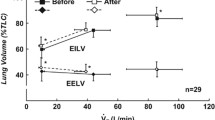Abstract
Twenty-three obese children, aged 9 to 14 years, ranging in percentage overweight from 26% to 83% (median 51.6%±16.3%), and 37 normal-weight children, matched for sex, age and height, performed a maximal exercise test on a treadmill. Cardiorespiratory performance was assessed by determination of the ventilatory anaerobic threshold (VAT) expressed in ml O2/min per kg and as a percent of maximal oxygen uptake (% VO2max). VAT and VO2max related to body weight were significantly lower (P<0.01) in the obese than in the normal-weight children. VAT % VO2max was similar in the two groups. A significant correlation was found between VAT and VO2max both in the obese (r=0.85) and in the control groups (r=0.79). The habitual level of physical activity was lower in the obese subjects compared to the control subjects (P<0.001). In conclusion our study shows that physical fitness of overweight children is quantitatively lowered and that it can be assessed by VAT. VAT does not require a maximal test and is particularly useful in the ergometric study of subjects with exercise intolerance.
Similar content being viewed by others
Abbreviations
- AT:
-
anaerobic threshold
- HR:
-
heart rate
- VAT:
-
ventilatory anaerobic threshold
- VCO2 :
-
carbon dioxide output
- VE:
-
ventilation
- VO2 :
-
oxygen uptake
- VO2max:
-
maximal oxygen uptake
References
Astrand PO, Rodahl K (1977) Textbook of work physiology: physiological bases of exercise. McGraw-Hill, New York
Bar-Or O (1983) Nutritional disease. In: Bar-Or O (ed) Pediatric sports medicine for the practitioner. Springer, Berlin Heidelberg New York, pp 168–226
Belko AZ, Van Loan M, Barbieri TF, Mayclin P (1987) Diet, exercise, weight loss and energy expenditure in moderately over-weight women. Int J Obes 11:93–104
Brooks AG (1985) Anaerobic threshold: review of the concept and directions for future research. Med Sci Sport Exerc 17:22–31
Caiozzo VJ, Davis JA, Ellis JF, Azus JL, Vandagriff R, Prietto CA, McMaster WC (1982) A comparison of gas exchange indices to detect the anaerobic threshold. J Appl Physiol 53:1184–1189
Cooper DM, Weiler-Ravel D (1984) Gas exchange response to exercise in children. Am Rev Resp Dis [Suppl] 129:47–48
Davis JA (1985) Anaerobic threshold: review of the concept and directions for future research. Med Sci Sports Exerc 17:6–18
Davis JA, Frank MH, Whipp BJ, Wasserman K (1979) Anaerobic threshold alterations caused by endurance training in middle aged men. J App, Physiol 46:1039–1046
Di Prampero PE (1986) The anaerobic threshold concept: a critical evaluation. Adv Cardiol 35:24–34
Dore' C, Hesp R, Wilkins D, Garrow JS (1982) Prediction of energy requirements of obese patients after massive weight loss. Hum Nutr Clin Nutr 36:41–48
Epstein LH, Wing RR, Penner BC, Kress MJ (1985) Effect of diet and controlled exercise on weight loss in obese children. J Pediatr 107:358–361
Farebrother MJE (1984) Respiratory function and cardiorespiratory response to exercise in obesity. Br J Dis Chest 73:211–229
Foss ML, Lampman RM, Schteingart DE (1980) Extremely obese patients: improvements in exercise tolerance with physical training and weight loss. Arch Phys Med Rehabil 61:119–124
Gaisl G, Buchberger J (1980) Determination of the aerobic and anaerobic threshold of 10–11 year old boys using blood gas analysis. In: Berg K, Erikson BO (eds) Children and exercise IX. University Park Press, Baltimore, pp 93–97
Garrow JS (1981) Treat obesity seriously: a clinical manual. Churchill Livingstone, London
Huttunen NP, Knip M, Paavilainen T (1986) Physical activity and fitness in obese children. Int J Obes 10:519–525
Kumagai S, Tanaka K, Matsuura Y, Matsuzaka K, Hirakoba K, Asano K (1982) Relationships of the anaerobic threshold with the 5km, 10km, and 10 mile races. Eur J Appl Physiol 49:13–23
Neary PJ, McDougall JD, Buchus R, Wenger HA (1985) The relationship between lactate and ventilatory thresholds: coincidental or cause and effect? Eur J Appl Physiol 54:104–108
Palgi Y, Gutin B, Young G, Alejandro D (1984) Physiologic and anthropometric factors underlying endurance performance in children. Int J Sports Med 5:67–73
Pavlou KN, Steffee WP, Lerman RH, Burrows BA (1985) Effects of dieting and exercise on lean body mass, oxygen uptake, and strength. Med Sci Sports Exerc 17:466–471
Powers SK, Dodd S, Deadson R, Byrd R, McKnight T (1983) Ventilatory threshold, running economy, and distance running performance of trained athletes. Res Q Exerc Sport 54:179–182
Ravussin E, Burnard B, Schutz Y, Jequier E (1982) Twentyfour hour energy expenditure and resting metabolic rate in obese, moderately obese and control subjects. Am J Clin Nutr 35:566–573
Reybrouck T, Weymans M, Ghesquiere J, Van Gerven D, Stijns H (1985) Ventilatory anaerobic threshold in children: age and sex differences. Eur J Appl Physiol 54:278–284
Reybrouck T, Weymans M, Stijns H, Van der Hauwaert LG (1986) Ventilatory anaerobic threshold for evaluating exercise performance in children with congenital left-to-right intracardiac shunt. Pediatr Cardiol 7:19–24
Reybrouck T, Weymans M, Vinckx J, Stijns H, Van der Schueren, Lodeweyckx M (1987) Cardiorespiratory function during exercise in obese children. Acta Paediatr Scand 76:342–348
Tanaka K, Matsuura J (1984) Marathon performance, anaerobic threshold, and onset of blood lactate accumulation. J Appl Physiol 57:640–643
Tanner JM, Whitehouse RH, Takaishi M (1966) Standards from birth to maturity for height, weight, height velocity and weight velocity: British children, 1965. Part II. Arch Dis Child 41:613–615
Wasserman K (1981) Physiology of gas exchange and exertional dyspnoea. Clin Sci 61:7–13
Wasserman K (1984) The anaerobic threshold measurement to evaluate exercise performance. Am Rev Respir Dis [Suppl] 129:35–40
Wasserman K, Whipp B, Koyal NS, Beaver WL (1973) Anaerobic threshold and respiratory gas exchange during exercise. J Appl Physiol 35:235–243
Whipp BJ (1984) The ventilatory stress of exercise in obesity. Am Rev Respir Dis [Suppl] 129:90–92
Author information
Authors and Affiliations
Rights and permissions
About this article
Cite this article
Zanconato, S., Baraldi, E., Santuz, P. et al. Gas exchange during exercise in obese children. Eur J Pediatr 148, 614–617 (1989). https://doi.org/10.1007/BF00441512
Received:
Accepted:
Issue Date:
DOI: https://doi.org/10.1007/BF00441512




